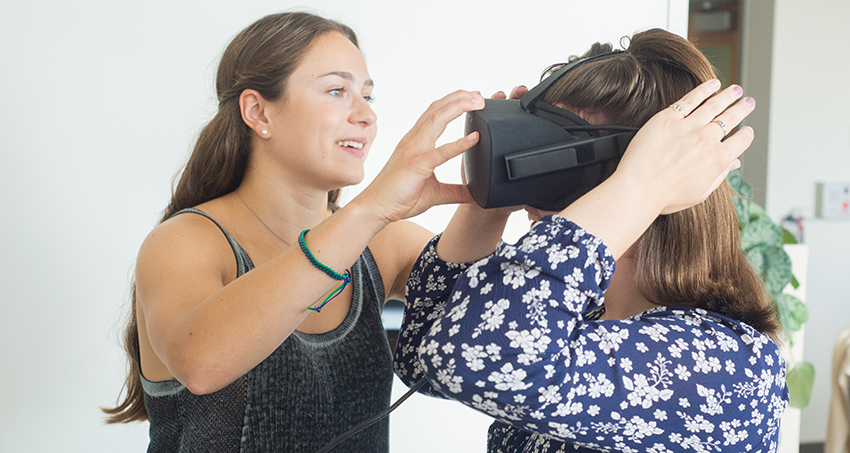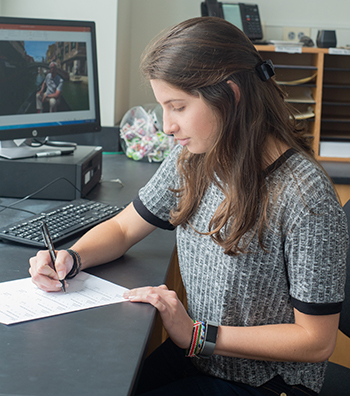How New Technology May Help Heal Old Traumas
This summer, one lab is using virtual reality goggles to experiment with human memory.By: Meghan Kita Monday, July 23, 2018 00:41 PM
 Rebecca Shear ’21 adjusts the virtual-reality goggles that she and three other students are using as part of their summer research. Photos by Maddy Kirchofer ’20.
Rebecca Shear ’21 adjusts the virtual-reality goggles that she and three other students are using as part of their summer research. Photos by Maddy Kirchofer ’20.The first thing the Gotthard Lab’s human research participants do is take a gondola ride through Venice. They listen to a mustachioed tour guide as he points out landmarks along the canal. They turn around and see the man paddling the boat. They hear the vessel as it cuts through the water. It looks and sounds like they’re visiting the Italian city, but they never leave the third floor of the New Science Building.
 “It feels very much like you’re there,” says associate professor of psychology and neuroscience Gretchen Gotthard, who is conducting memory experiments using virtual-reality (VR) goggles with the help of four student researchers. While Alison Bashford ’20, Desiree Bsales ’20, Jessica-Ann Golbitz ’19 (pictured) and Rebecca Shear ’21—all neuroscience majors—are also assisting with the lab’s ongoing memory research using rats, the VR component was added just last summer.
“It feels very much like you’re there,” says associate professor of psychology and neuroscience Gretchen Gotthard, who is conducting memory experiments using virtual-reality (VR) goggles with the help of four student researchers. While Alison Bashford ’20, Desiree Bsales ’20, Jessica-Ann Golbitz ’19 (pictured) and Rebecca Shear ’21—all neuroscience majors—are also assisting with the lab’s ongoing memory research using rats, the VR component was added just last summer.
Memory, in a Nutshell
To explain the research, which receives funding from the Neuroscience Collaborative Research Program, Gotthard first describes the terms “consolidation” and “reconsolidation.” When a memory is created—when it moves from short-term into long-term memory—that’s called consolidation. When an experience already in long-term memory is recalled and reactivated, it then undergoes reconsolidation, a process that can serve to strengthen, weaken or otherwise modify the existing memory.
A study from a few years ago showed that long-term memories could be altered in this way, which has practical applications: “Before we believed that if someone has PTSD and they experienced their trauma 20 years ago, the idea was sort of stuck,” Gotthard says. “Now we know we can remind them of the memory and do different things to change or weaken the memory.”
How the Experiment Works
In the Gotthard lab, they’re trying to learn whether VR games could help modify a memory in this way. They’re using VR to create a memory and later, in a third of the participants, to try to disrupt that memory during reconsolidation.
To start, each participant takes the same gondola ride, and afterward, they write down everything they remember from it (a “free-recall” exercise). The researchers use that free-recall information to create a distinct 20-question, multiple-choice "recognition questionnaire” for each participant.
Participants return the following day, see a slideshow of stills from the gondola ride to reactivate their memory of it and then do one of three activities: a coloring exercise, a game of Tetris on the computer or a game using the VR goggles. The VR game requires the player to use virtual air-traffic-controller-like flashlights to hit virtual objects that fly toward them as techno music plays.
One week later, each participant returns to do another free-recall exercise and then to take their individualized recognition questionnaire.
Looking Ahead
While the group doesn’t have data to analyze yet, they hypothesize that the VR-game group may remember less than the other groups. “The game is a visuospatial distractor, which means it’s going to overload your working memory and require your brain to be active in the way that it would normally be active to consolidate a memory,” says Rebecca. “This competition between the visuospatial task and the original memory leads to a weakening of the original memory.”
If the data supports that theory, Gotthard says VR could be used to complement traditional methods for dealing with post-traumatic stress disorder.
“What often happens in regular cognitive behavioral therapy (CBT) is people come in and they talk to a therapist about issues that are happening but they might not want to talk about the trauma,” Gotthard says. “These visuospatial techniques can weaken the emotional aspects of the traumatic memory, making it easier to talk about in CBT sessions.”
.jpg)
From left, Desiree Bsales ’20, Alison Bashford ’20, Jessica-Ann Golbitz ’19 and Rebecca Shear ’21.
